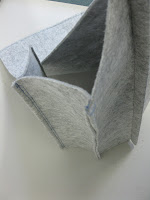PROJECT NAME: Material Activity
DESIGN TYPE: Office Furniture
FURNITURE TYPE: Inhabitable partition
PROJECT DETAILS: Studio Practice 4 2011
PROJECT LOCATION: Open plan corporate office
PROJECT TUTORS: Cris de Groot
FINAL PROJECT GRADE: A-
BRIEF: Using a new textile product called Echo Panel Mura by the Australian textile manufacturer Woven Image, create an artifact that caters to the modern, open plan, corporate office environment for the real-life, New Zealand based, office furniture client Europlan.
This is my design response to the 'Material Activity' brief, called the Human Utility Module, or HUM for short.
The Human Utility Module is about facilitating the reconnection of human beings with their primal spatial necessities in an open plan office.
The inspiration behind HUM extends from the caves our ancestors once inhabited millions of years ago as a form of refuge, privacy and enclosure from the natural environment.
The architecture of man has since evolved to adapt to the transient lifestyles of the modern human, but the service of refuge, privacy and enclosure remains vital to the psyche of the human mind.
In a working environment this remains the same.

Basically this translates to: “The right environment ‘equals’ a better output.”
In an open plan office there are different degrees of individual and collaborative work that requires the support of the right environment.
HUM aims to humanize the open plan office by encouraging informal ways of working and socializing through the removal of the rigid office cubical….
And replacing it with a flexible alternative, which supports individual privacy, as well as the equally important nature of collaborative work.
This is HUM. It was aesthetically inspired by the poetic nature of a Humming Bird.
Echo Panel Mura is the primary material used to construct two flexible, wing-shaped panels that reflect the attributes of a Humming Birds lightness, agility, beauty, technology, and animation.
Because of its dual sided-ness, HUM can be used as an inhabitable partition.
The wings can overlap to create over 5 different forms that cater to a gradient of private and social activities.
This simple adjustment addresses the needs for an artifact that is adaptable to the ever-changing demands on today’s employers and employees.
Using the acoustic properties of Echo Panel Mura, HUM can be used as a personal quiet zone for taking phone calls or resting, for example.
By spreading the feet of the wings, the user can quickly change their external visibility. This can be used to eliminate visual distractions and improve the users focus.
The need for private space extends beyond the corporate environment and in to other spaces such as: Large open spaces in general, retail, educational facilities, libraries, hotel lobbies, cafes and restaurants.
HUM blurs the lines between private and public, enclosure and exposure, the individual and the collaborative, and in the process challenges the traditional and conventional environments of a corporate office.
By increasing the boundaries of what is considered acceptable, a more modern office space will emerge providing new ways of working and thinking, and I believe HUM can facilitate this future.
HUM STUDIO PHOTO SHOOT

HUM CONCEPT AND DEVELOPMENT
DESIGN CONCEPT MODELS:
STRUCTURAL CONCEPT MODELS:
1:1 DEVELOPMENT MODEL:
MATERIAL TESTING:
STRUCTURAL DEVELOPMENT MODEL:
1:1 PROTOTYPE DEVELOPMENT:
1:1 PROTOTYPE FINAL:













































































































No comments:
Post a Comment